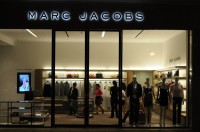
This season’s Marc Jacobs fashion show got attention for its use of colorful dreadlocks worn by white models. (Courtesy of Flickr)
By Kathleen Quinlisk
While sky-high platform heels and vibrant palettes made a splash at Marc Jacobs’ New York Fashion Week show, it was cultural appropriation that ultimately stole the show.
The show received critical acclaim and featured several unifying themes: platform heels, patterned thigh-high socks, metallic neutrals and — most notably — primarily white models sporting multi-colored, dreadlock-embellished and punk rock updos.
Photos from the show surfaced online, and angry headlines followed. The question of whether or not Marc Jacobs’ stylistic use of dread locks was an exploitation of oppressed minority culture also dominated social media in the days following the show.
It may seem tempting to dismiss the accusations fired toward Marc Jacobs’ Spring 2016 show as just another incident of political correctness hampering creativity. However, upon closer examination of the show, these accusations actually hold some weight.
A world where cultures exist in social hierarchies and systems of inequality, it breeds cross-cultural interaction. Cultural appropriation occurs when a socially privileged group that claims the style of an oppressed group without recognizing the significance or legitimacy of that style in the context of its mother culture.
Marc Jacobs is undoubtedly guilty of culturally appropriating dreadlocks. Though the exact history of dreads is factually muddled (as the histories of styles this old typically are), CNN reported that dreads likely first appeared in Ancient Egypt, popularized by Jamaican Rastafarians. They were worn not as simply an aesthetic style, but rather as a symbol of their African heritage and a tribute to their deviation from “Babylon,” a word they used to refer to “a historically white-European imperialist structure that has oppressed blacks and other people of color since way back when.”
Since their Jamaican popularization, dreads have become a significant feature of the black identity. While dreads have been absorbed stylistically into the grunge and punk-rocks scenes, the style cannot be divorced from its historically black origins.
The origins of the multi-colored dread extensions used in Marc Jacobs’ show are distinctly non-black, in fact.
White Etsy vendor Jen Counts, was recruited by wildly renowned Guido Palau, the hair stylist for the show, according to New York Magazine. Counts, a Florida-based producer of homespun, hand-dyed hair extensions, worked to create over 300 color variations of the dreads specifically edited by Marc Jacobs himself. With the help of her daughter, Counts crafted 55 dreads for each model in the show.
By recruiting a non-black artisan, Marc Jacobs made the production of his dread accessory non-black, and by hand-picking the color of each dread, he made his dread accessory visually non-black. The designer further bleached his dreads by casting a majority of white models in his show, one Jourdan Dunn to every group of Bella Hadid, Gigi Hadid, Kendall Jenner, Karlie Kloss, Taylor Hill and Stella Maxwell.
Marc Jacobs’ Spring 2016 show featured this season’s cut of cultural appropriation. This verdict of guilt may seem like excessive politicization, but it is difficult to depoliticize fashion when Vogue describes this whitened runway style as “1970s halos of dreadlocks.” Even “Fashion Police” host, Giuliana Rancic, speculated that Zendaya’s dreads “smelt of patchouli oil or weed” on the 2015 Oscars red carpet.
Though it may seem trivial, coming down hard and decisively on incidents of cultural appropriation is extremely important, and dismissing then can be dangerous. For example, stylist Guido Palau attempted to defend Marc Jacobs. In Harper’s Bazaar, explaining the varied influence behind the dread look. “We were also looking at other girls that were inspiring to Marc, and certain types of cultures, like rave culture, club culture, and acid house,” Palau said.
At first, this seems reasonable. After all, no style can maintain perfect cultural purity in today’s global world. Dreads have made their way into other scenes.
But Palau’s response raises some tough follow up questions. Why club culture over black culture? Why are you more inspired by blond rave dreads than black dreads? If dreads are a cornerstone style of both black culture and punk-rock culture, why is one more runway worthy than the other?
These are the questions that make accusations of cultural appropriation extremely difficult to dismiss as cases of oversensitivity or excessive political correctness. Marc Jacobs reclaimed dreads as his own, and severed them from their black cultural context.
Kathleen Quinlisk, FCRH ’18, is an English major from West Chester, Pennslyvania.

Why are you, a white journalist, culturally appropriating traditionally black topics, like complaining about white privilege and oppression? Feeling oppressed has definitely become a significant feature of black identity. Instead of allowing a black person to write this article, you have taken the issue as your own and are contributing to the culture of white people crowding out the black social justice movement.